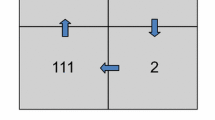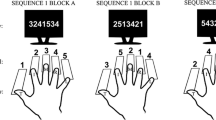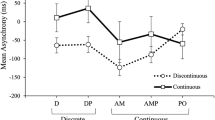Abstract
This study investigated aspects of individual differences in timing of continuous and discontinuous movements to different pacing signals (auditory or visual), pacing intervals (500, 650, 800, 950 ms), and across effectors (dominant versus non-dominant hand). Correlation and principal component analysis demonstrated that a single statistical dimension accounted for up to 60 % of the explained variance in discontinuous tasks and 25 % of the variance in continuous tasks, when applied to performance obtained from tasks conducted with different effectors and at different pacing rates. Correlation analysis of factor scores representing effector and rate independent task performances showed that timing of discrete or continuous movements can be associated with modality independent mechanisms. Timing variability from discrete and continuous trials was not significantly correlated. This study goes beyond previous correlational work on individual differences in discrete and continuous movements, demonstrating that individual differences in discrete (event-based) or continuous (emergent) motor timing tasks can be modeled as distinctive statistical components with dissimilar capability to capture effector, rate, and modality independent variance.



Similar content being viewed by others
References
Aschersleben, G. (2002). Temporal control of movements in sensorimotor synchronization. Brain and Cognition, 48(1), 66–79. doi:10.1006/brcg.2001.1304.
Avanzino, L., Bove, M., Tacchino, A., Ruggeri, P., Giannini, A., Trompetto, C., et al. (2009). Cerebellar involvement in timing accuracy of rhythmic finger movements in essential tremor. European Journal of Neuroscience, 30(10), 1971–1979. doi:10.1111/j.1460-9568.2009.06984.x.
Birkett, E. E., & Talcott, J. B. (2012). Interval timing in children: effects of auditory and visual pacing stimuli and relationships with reading and attention variables. PLoS ONE, 7(8), e42820. doi:10.1371/journal.pone.0042820.
Braitenberg, V. (1967). Is the cerebellar cortex a biological clock in the millisecond range? Progress in Brain Research, 25, 334–346. doi:10.1016/S0079-6123(08)60971-1.
Buonomano, D. V. (2000). Decoding temporal information: a model based on short-term synaptic plasticity. Journal of Neuroscience, 20(3), 1129–1141.
Cattell, R. B. (1966). Scree test for number of factors. Multivariate Behavioral Research, 1(2), 245–276. doi:10.1207/s15327906mbr0102_10.
Distefano, C., Zhu, M., & Mindrila, D. (2009). Understanding and using factor scores: considerations for the applied researcher. Practical asessment, Ressearch & Evaluation, 14(20), 1–11.
Franz, E. A., Zelaznik, H. N., & Smith, A. (1992). Evidence of common timing processes in the control of manual, orofacial, and speech movements. Journal of Motor Behavior, 24(3), 281–287.
Green, J. T., Ivry, R. B., & Woodruff-Pak, D. S. (1999). Timing in eyeblink classical conditioning and timed-interval tapping. Psychological Science, 10(1), 19–23. doi:10.1111/1467-9280.00100.
Hary, D., & Moore, G. P. (1987a). On the performance and stability of human metronome-synchronization strategies. British Journal of Mathematical and Statistical Psychology, 40, 109–124.
Hary, D., & Moore, G. P. (1987b). Synchronizing human movement with an external clock source. Biological Cybernetics, 56(5–6), 305–311. doi:10.1007/Bf00319511.
Horn, J. L. (1965). A rationale and test for the number of factors in factor analysis. Psychometrika, 30, 179–185.
Ivry, R. B., & Hazeltine, R. E. (1995). Perception and production of temporal intervals across a range of durations—evidence for a common timing mechanism. Journal of Experimental Psychology-Human Perception and Performance, 21(1), 3–18. doi:10.1037//0096-1523.21.1.3.
Ivry, R. B., & Spencer, R. M. C. (2004). The neural representation of time. Current Opinion in Neurobiology, 14(2), 225–232, doi:10.1016/j.conb.2004.03.013.
Ivry, R. B., Spencer, R. M., Zelaznik, H. N., & Diedrichsen, J. (2002). The cerebellum and event timing. Cerebellum: Recent Developments in Cerebellar Research, 978, 302–317. doi:10.1111/j.1749-6632.2002.tb07576.x.
Jacoby, N., & Repp, B. H. (2012). A general linear framework for the comparison and evaluation of models of sensorimotor synchronization. Biological Cybernetics, 106(3), 135–154. doi:10.1007/s00422-012-0482-x.
Jantzen, K. J., Steinberg, F. L., & Kelso, J. A. (2004). Brain networks underlying human timing behavior are influenced by prior context. Proceedings of the National Academy of Science of the United States of America, 101(17), 6815–6820. doi:10.1073/pnas.0401300101.
Jantzen, K. J., Steinberg, F. L., & Kelso, J. A. (2005). Functional MRI reveals the existence of modality and coordination-dependent timing networks. Neuroimage, 25(4), 1031–1042. doi:10.1016/j.neuroimage.2004.12.029.
Karmarkar, U. R., & Buonomano, D. V. (2007). Timing in the absence of clocks: encoding time in neural network states. Neuron, 53(3), 427–438. doi:10.1016/j.neuron.2007.01.006.
Kay, B. A., Saltzman, E. L., Kelso, J. A. S., & Schoner, G. (1987). Space-time behavior of single and bimanual rhythmical movements—data and limit-cycle model. Journal of Experimental Psychology-Human Perception and Performance, 13(2), 178–192. doi:10.1037//0096-1523.13.2.178.
Keele, S. W., & Ivry, R. (1990). Does the cerebellum provide a common computation for diverse tasks—a timing hypothesis. Annals of the New York Academy of Sciences, 608, 179–211. doi:10.1111/j.1749-6632.1990.tb48897.x.
Keele, S. W., Ivry, R. I., & Pokorny, R. A. (1987). Force control and its relation to timing. Journal of Motor Behavior, 19(1), 96–114.
Keele, S. W., Pokorny, R. A., Corcos, D. M., & Ivry, R. (1985). Do perception and motor production share common timing mechanisms—a correlational analysis. Acta Psychologica, 60(2–3), 173–191. doi:10.1016/0001-6918(85)90054-X.
Lorås, H., Sigmundsson, H., Ohberg, F., & Stensdotter, A-K. (2013). Temporal control of discrete or rhythmical movements: the kinematic-difference hypothesis. (Submitted).
Lorås, H., Sigmundsson, H., Talcott, J. B., Ohberg, F., & Stensdotter, A. K. (2012). Timing continuous or discontinuous movements across effectors specified by different pacing modalities and intervals. Experimental Brain Research, 220(3–4), 335–347. doi:10.1007/s00221-012-3142-4.
Mates, J. (1994). A model of synchronization of motor acts to a stimulus sequence. 1. Timing and error corrections. Biological Cybernetics, 70(5), 463–473. doi:10.1007/Bf00203239.
Oldfield, R. C. (1971). The assessment and analysis of handedness: the Edinburgh inventory. Neuropsychologia, 9(1), 97–113.
Osborne, J. W., Costello, A. B. (2004). Sample size and subject to item ratio in principal components analysis. Practical Assessment, Research & Evaluation, 9(11).
Repp, B. H. (2003). Rate limits in sensorimotor synchronization with auditory and visual sequences: the synchronization threshold and the benefits and costs of interval subdivision. Journal of Motor Behavior, 35(4), 355–370.
Repp, B. H. (2005). Sensorimotor synchronization: a review of the tapping literature. Psychonomic Bulletin & Review, 12(6), 969–992. doi:10.3758/Bf03206433.
Repp, B. H., & Penel, A. (2002). Auditory dominance in temporal processing: new evidence from synchronization with simultaneous visual and auditory sequences. Journal of Experimental Psychology-Human Perception and Performance, 28(5), 1085–1099. doi:10.1037//0096-1523.28.5.1085.
Repp, B. H., & Penel, A. (2004). Rhythmic movement is attracted more strongly to auditory than to visual rhythms. Psychological Research-Psychologische Forschung, 68(4), 252–270. doi:10.1007/s00426-003-0143-8.
Robertson, S. D., Zelaznik, H. N., Lantero, D. A., Bojczyk, K. G., Spencer, R. M., Doffin, J. G., et al. (1999). Correlations for timing consistency among tapping and drawing tasks: evidence against a single timing process for motor control. Journal of Experimental Psychology-Human Perception and Performance, 25(5), 1316–1330. doi:10.1037//0096-1523.25.5.1316.
Schoner, G. (2002). Timing, clocks, and dynamical systems. Brain and Cognition, 48(1), 31–51. doi:10.1006/brcg.2001.1302.
Spencer, R. M. C., & Zelaznik, H. N. (2003). Weber (slope) analyses of timing variability in tapping and drawing tasks. Journal of Motor Behavior, 35(4), 371–381.
Spencer, R. M. C., Zelaznik, H. N., Diedrichsen, J., & Ivry, R. B. (2003). Disrupted timing of discontinuous but not continuous movements by cerebellar lesions. Science, 300(5624), 1437–1439. doi:10.1126/science.1083661.
Studenka, B. E., & Zelaznik, H. N. (2008). The influence of dominant versus non-dominant hand on event and emergent motor timing. Human Movement Science, 27(1), 29–52. doi:10.1016/j.humov.2007.08.004.
Studenka, B. E., & Zelaznik, H. N. (2011a). Circle drawing does not exhibit auditory-motor synchronization. Journal of Motor Behavior, 43(3), 185–191. doi:10(1080/00222895).2011.555796.
Studenka, B. E., & Zelaznik, H. N. (2011b). Synchronization in repetitive smooth movement requires perceptible events. Acta Psychologica, 136(3), 432–441. doi:10.1016/actpsy.2011.01.011.
Studenka, B. E., Zelaznik, H. N., & Balasubramaniam, R. (2012). The distinction between tapping and circle drawing with and without tactile feedback: an examination of the sources of timing variance. Quarterly Journal of Experimental Psychology, 65(6), 1086–1100. doi:10.1080/17470218.2011.640404.
Torre, K., & Balasubramaniam, R. (2009). Two different processes for sensorimotor synchronization in continuous and discontinuous rhythmic movements. Experimental Brain Research, 199(2), 157–166. doi:10.1007/s00221-009-1991-2.
Torre, K., Balasubramaniam, R., Rheaume, N., Lemoine, L., & Zelaznik, H. N. (2011). Long-range correlation properties in motor timing are individual and task specific. Psychonomic Bulletin & Review, 18(2), 339–346. doi:10.3758/s13423-011-0049-1.
Torre, K., & Delignieres, D. (2008). Distinct ways of timing movements in bimanual coordination tasks: contribution of serial correlation analysis and implications for modeling. Acta Psychol (Amst), 129(2), 284–296. doi:10.1016/j.actpsy.2008.08.003.
Vorberg, D., & Schulze, H. H. (2002). Linear phase-correction in synchronization: predictions, parameter estimation, and simulations. Journal of Mathematical Psychology, 46(1), 56–87. doi:10.1006/jmps.2001.1375.
Wiener, M., Turkeltaub, P., & Coslett, H. B. (2010). The image of time: a voxel-wise meta-analysis. Neuroimage, 49(2), 1728–1740. doi:10.1016/j.neuroimage.2009.09.064.
Wing, A. M. (2002). Voluntary timing and brain function: an information processing approach. Brain and Cognition, 48(1), 7–30. doi:10.1006/brcg.2001.1301.
Yeomans, K. A., & Golder, P. A. (1982). The Guttman-Kaiser criterion as a predictor of the number of common factors. Statistician, 31(3), 221–229. doi:10.2307/2987988.
Zelaznik, H. N., & Rosenbaum, D. A. (2010). Timing processes are correlated when tasks share a salient event. Journal of Experimental Psychology-Human Perception and Performance, 36(6), 1565–1575. doi:10.1037/A0020380.
Zelaznik, H. N., Spencer, R. M., & Doffin, J. G. (2000). Temporal precision in tapping and circle drawing movements at preferred rates is not correlated: further evidence against timing as a general-purpose ability. Journal of Motor Behavior, 32(2), 193–199.
Zelaznik, H. N., Spencer, R. M. C., & Ivry, R. B. (2002). Dissociation of explicit and implicit timing in repetitive tapping and drawing movements. Journal of Experimental Psychology-Human Perception and Performance, 28(3), 575–588. doi:10.1037//0096-1523.28.3.575.
Zelaznik, H. N., Spencer, R. M. C., Ivry, R. B., Baria, A., Bloom, M., Dolansky, L., et al. (2005). Timing variability in circle drawing and tapping: probing the relationship between event and emergent timing. Journal of Motor Behavior, 37(5), 395–403. doi:10.3200/Jmbr.37.5.395-403.
Zoski, K. W., & Jurs, S. (1996). An objective counterpart to the visual scree test for factor analysis: the standard error scree. Educational and Psychological Measurement, 56(3), 443–451. doi:10.1177/0013164496056003006.
Acknowledgments
We thank the students from the University College for participating in the study.
Author information
Authors and Affiliations
Corresponding author
Rights and permissions
About this article
Cite this article
Lorås, H., Stensdotter, A.K., Öhberg, F. et al. Individual differences in timing of discrete and continuous movements: a dimensional approach. Psychological Research 78, 289–299 (2014). https://doi.org/10.1007/s00426-013-0496-6
Received:
Accepted:
Published:
Issue Date:
DOI: https://doi.org/10.1007/s00426-013-0496-6




